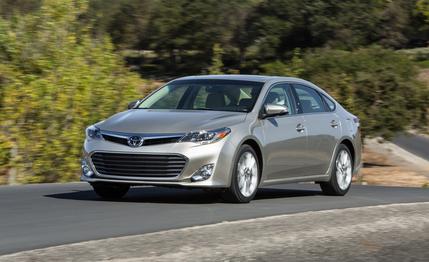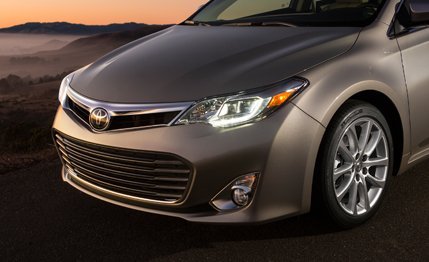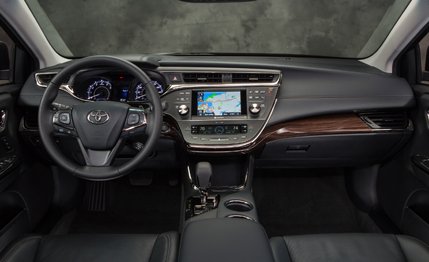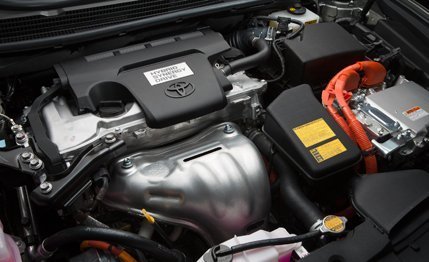 First Drive Review
First Drive Review
In 1994, Toyota wrote a love letter to AARP and called it the Avalon. A stretched Camry, the Avalon replicated the classic American car with a vast rear seat, a column shifter, and a front bench seat. Even the name served up a warm bowl of nostalgia, simultaneously conjuring the old movie house on Main Street, Hugh Downs, and a back rub from Jessica Tandy. Soft, comfortable, and spacious, the Avalon chased the Big Three right down the big-car rabbit hole.
Toyota is now maintaining that the new, redesigned 2013 Avalon is a car for buyers who have yet to notice their first liver spot. It’s worth noting that Toyota made the same claim in 2005 after slipping a 3.5-liter V-6 into the contemporary Avalon. We welcomed the extra power, but the car’s soft suspension and casual roll control failed to connect. That didn’t stop us from giving the ’05 Avalon a comparison-test win against some admittedly ineffectual competition. But the recycled claim that this new Avalon isn’t just for old folks might actually hold water. The chassis has been slipped a Viagra, there’s an emphasis on driver involvement, and the styling marks a clean break from yesteryear’s examples.

Trimmed and Toned
The exterior design seems to borrow from a number of sources, including Hyundai, Lexus, and Infiniti—and the grille placement and shape recall the second-gen Chrysler Sebring—but the net effect is a sedan that doesn’t immediately conjure images of applesauce and cribbage. That’s a good thing. On the driving front, the stiffened suspension keeps body roll in check, and the previous car’s acceleration squat and earth-plowing dive under hard braking are things of the past. The steering now requires effort, and even more weight can be dialed in by hitting the Sport button located between the seats. Jack LaLanne himself would be pleased with the Avalon’s transformation from flabby and sloppy to tight and athletic.
Power remains the same at 268 hp, but muscle was never the Avalon’s problem. The familiar 3.5-liter V-6 and six-speed automatic are standard and carry over from the outgoing car. Paddle shifters are fitted to the top two trims, the Touring and the Limited. The previous Avalon hit 60 mph in 6.6 seconds when we tested it a couple of summers ago, and the new car should easily match or beat that time, despite having a taller final-drive ratio, because weight is down by approximately 100 pounds, according to Toyota. The structure is stiffer than the previous version, too, which has helped make powertrain, suspension, and road noise even more hushed than before—and decidedly Lexus-like. We had a chance to sample new and old models back-to-back, and the latest Avalon feels more modern, more solid, quieter, and more expensive.

Riding in Style
The redesigned interior represents a massive upgrade. Leather upholstery covers the seats in every Avalon, and a vinyl-wrapped dashboard gives the appearance of real hide. Opt for the gray or tan interior, and there are contrasting colors throughout. At night, ambient lighting glows out of the base of the dashboard, à la Mercedes-Benz S-class. The Avalon’s 111.0-inch wheelbase is unchanged, yet rear legroom is down 1.7 inches, due to the rear chairs being moved slightly forward to co-exist with the sloping, contemporary roofline. Riders will find that the rear seat remains large and comfortable, though; Toyota believes it’s spacious enough to test the waters of the livery market with the new model (orders accepted for black cars only, please).
For drivers who want to stretch each gallon of gas, Toyota is offering the Camry hybrid’s powertrain in the Avalon. The first-ever Avalon hybrid boasts estimated economy numbers of 40 mpg in the city and 39 mpg on the highway and 40 mpg combined. The electric motor and the 2.5-liter four-cylinder combine to put out 200 hp, and under very gentle acceleration, electric-only power is available up to 20 mph. An old-school nickel-metal hydride battery pack sits behind the rear seat and reduces trunk space from 16 to 14 cubic feet—eco warriors have to sacrifice something for the extra mpg, after all. Spring rates are tailored for the hybrid, but the tuning is intended to retain the flavor of the conventional model.

Spending the Grandkids’ Inheritance
The base Avalon XLE V-6 opens at $31,750—$2205 less than the ’12—and the Limited V-6 tops the range at $40,410. (The hybrid hardware commands a roughly $2000 premium and can only be fitted to the Premium, Touring, and Limited models.) Unlike its predecessor, the 2013 Avalon makes sense in the Toyota/Lexus hierarchy, and it’s better to drive than the Lexus ES and the Camry while delivering luxury and refinement that neatly split those two cars. The Avalon’s typical customers needn’t fret, however, as the car isn’t so firmed up that they’ll feel alienated. Against its front-drive rivals such as the Buick LaCrosse, Ford Taurus, and Hyundai Azera, the Avalon looks strong, although it’s likely that we’d favor the more dynamic rear-drive competition—namely, the Chrysler 300 and the Hyundai Genesis—in a comparison test.
Although Toyota hasn’t turned the Avalon into a sports sedan, it has added athleticism and a few pinches of sophistication—improvements that should make sense to everyone, regardless of AARP eligibility.